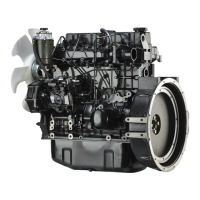
Do you have a question about the Mitsubishi SS series and is the answer not in the manual?
| Brand | Mitsubishi |
|---|---|
| Model | SS series |
| Category | Engine |
| Language | English |
Guidance for daily recording of engine operation to aid in troubleshooting and maintenance.
List of recommended items to record for engine operation and maintenance.
Safety precautions to prevent fires and explosions related to fuel and electrical systems.
Precautions to avoid burns from hot engine components or pressurized coolant.
Guidelines for safely lifting the engine and avoiding hazards during the process.
Safety advice on operating the engine in well-ventilated areas to avoid exhaust fumes.
Warning to stay clear of all rotating and moving parts during engine operation.
Essential safety measures to follow before, during, and after engine maintenance.
Key safety guidelines for operating the engine, including break-in and warm-up procedures.
Guidelines for operating the engine correctly to ensure performance and longevity.
Instructions for proper engine servicing, including cleaning and maintenance.
Procedures and advice for dealing with abrupt engine stops, overheating, or low oil pressure.
Diagram and labels identifying components of the S4S engine model.
Diagram and labels identifying components of the S4S-DT engine model.
Diagram and labels identifying components of the S6S engine model.
Diagram and labels identifying components of the S6S-DT engine model.
Procedure for performing a visual inspection of the engine before starting.
Detailed steps for starting the engine, with or without a glow timer.
Procedure and importance of warming up the engine before full operation.
Instructions for applying load to the engine after it has warmed up.
Procedure for stopping the engine using a keystop device.
Maintenance tasks to be performed every 50 service hours, including fuel system and battery checks.
Maintenance tasks to be performed every 250 hours or annually, including oil and filter changes.
Maintenance tasks to be performed every 500 service hours.
Maintenance tasks to be performed every 2 years, such as coolant replacement.
Maintenance tasks to be performed as needed, such as priming the fuel system and cleaning the air cleaner.
Guidance on selecting appropriate fuels for optimal engine performance and longevity.
Best practices for maintaining the diesel fuel tank to prevent contamination and condensation.
Recommendations for ensuring clean fuel supply and storage to maintain engine health.
Guidance on selecting engine oils that meet API classifications for proper lubrication.
Chart showing recommended oil viscosities based on ambient temperature for reliable starting.
Specifications for engine coolant, including chemical properties and corrosion/scale formation limits.
Recommendations for Long Life Coolant (LLC) types and their suitability for engine cooling.
Instructions for using non-amine type LLC, including change intervals and concentration.
Explanation of the benefits and function of Long Life Coolant (LLC) in engine cooling systems.
Detailed explanation of how Long Life Coolant (LLC) functions to protect engine components.
Case studies illustrating circuit trouble caused by incorrect coolant additives.
Detailed procedures for preparing the engine for long-term storage to prevent damage.
Procedures for storing the engine in an operational condition, such as after short-term use.
Maintenance tasks to perform while the engine is in storage.
General advice and thinking process for diagnosing engine problems.
A table listing common engine problems, their causes, and recommended corrections.